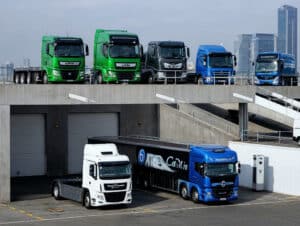Importing is the lifeblood of the trucks and buses industry. Vehicles, parts, and accessories flow across borders every day, connecting suppliers, dealers, and customers in a global network. But ask any operations manager or supply chain leader and they will tell you: managing imports is no easy task.
Regulations change overnight. A missing customs document can stall shipments for weeks. An unexpected tariff can turn a profitable deal into a loss. A delayed part can mean a customer’s fleet is stuck in the yard instead of on the road.
In short, import management for trucks and buses is critical, but they’re also a constant source of stress.
It’s not that businesses don’t care about getting it right. It’s that traditional tools and manual processes simply cannot keep up with the speed, complexity, and risks involved in modern global trade. That is why so many trucks and buses businesses find themselves firefighting import problems instead of confidently managing them.
But what if import management for trucks and buses could be more than damage control? What if it could become a source of efficiency, resilience, and even competitive advantage?
That is exactly what A365 Trucks & Buses Import Management is designed to deliver.
Why import management for trucks and buses businesses is so complex
If you work in trucks and buses, you already know the pain points. Import management is rarely just about “getting parts in.” It involves a tangled web of suppliers, dealers, logistics providers, customs authorities, and internal teams, all of whom need to be aligned. And when they’re not, things unravel quickly.
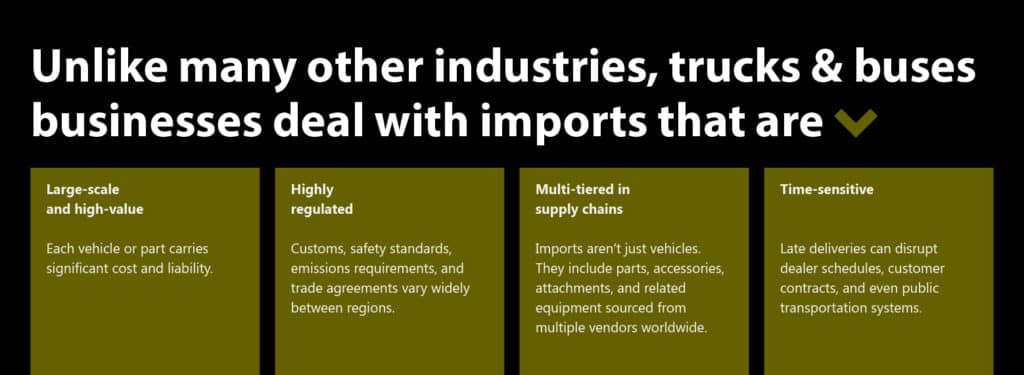
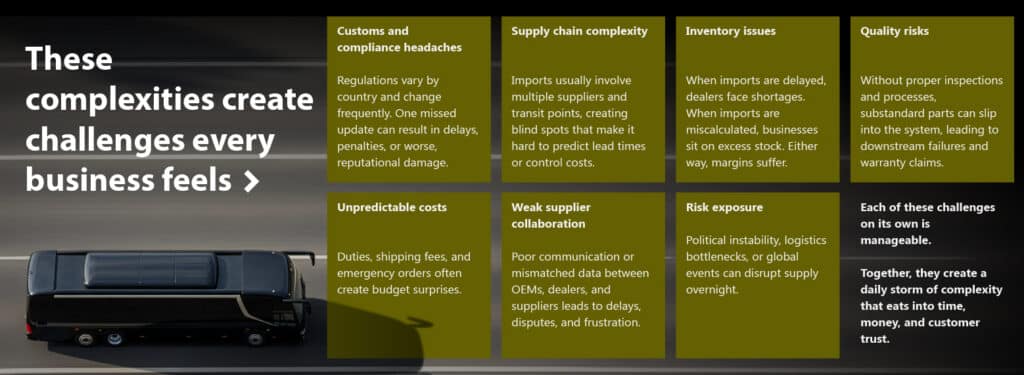
The old way: A story of constant firefighting
Imagine this scenario.
A dealer urgently needs a batch of parts to service a bus fleet. The OEM places the order, but paperwork errors mean the shipment gets stuck at customs. By the time the issue is resolved, the dealer has had to placate frustrated customers, the OEM has scrambled to arrange emergency shipments, and costs have ballooned.
Meanwhile, another shipment of accessories arrives with no proper quality checks in place. Some of them fail after installation, leading to warranty claims and more costs. The finance team tries to reconcile expenses, but with data scattered across spreadsheets and disconnected systems, they cannot see where the money is going.
This is the old way of import management for trucks and buses: reactive, fragmented, and risky.
The new way: Import management for trucks and buses businesses with A365
Now imagine the same scenario with A365 Trucks & Buses Import Management in place.
As soon as the order is created, customs requirements are automatically checked and documents are generated in the correct format. Suppliers upload data through a connected portal, ensuring nothing gets lost in email chains. Inventory is tracked in real time, so the dealer can see expected arrival dates directly in the system.
When the shipment arrives, automated quality inspections catch any issues before the parts are distributed. Finance teams have full visibility into costs and duties, preventing budget shocks. Analytics highlight supplier performance, helping managers spot patterns and negotiate better terms.
Instead of firefighting, the business is in control.
This is the promise of A365: to turn import management for trucks and buses from a liability into a strategic advantage.
Free access: Visit our Digital Experience Center and see how A365 can help you turn your import operations into a strategic driver of success
What A365 delivers in practice
A365 Trucks & Buses Import Management is not just a software platform. It’s a transformation of how businesses approach imports. Here’s what it makes possible:
- Simplified imports: Every document, process, and transaction is managed in one place, reducing duplication and errors.
- Stronger compliance: Automated checks and organized documentation mean businesses are always prepared for audits and regulatory reviews.
- Smarter control: With real-time data and AI-powered insights, managers can make decisions based on facts, not guesswork.
- Cost efficiency: Automated financial management keeps budgets under control and highlights areas for savings.
- Resilience: Better visibility and collaboration reduce risks, even when global conditions are unpredictable.
What makes A365 different: The Microsoft foundation
A365 is a cloud-native solution that unifies Enterprise Resource Planning (ERP), Customer Relationship Management (CRM), and Dealer Management System (DMS) capabilities into a modular, evergreen platform. A365 offers deep integration, scalability, built-in Artificial Intelligence (AI), and continuous innovation, helping businesses stay competitive and ready for what’s next.
At the heart of A365 is the Microsoft ecosystem. Built on Microsoft Dynamics 365, Azure, Copilot, Power Platform, and Dataverse, A365 leverages the world’s most trusted business technology stack.
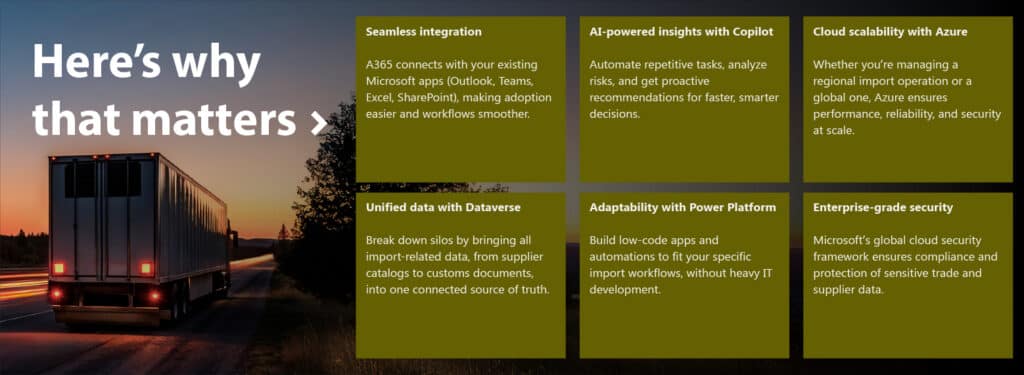
Real-world scenarios: Old way vs. A365 way
To see the difference A365 makes, let’s compare the old way of import management for trucks and buses with the A365 way.
- Customs compliance
- Old way: A compliance officer scrambles to collect documents from email threads and files, often missing updates and risking fines.
- A365 way: All customs documents are automatically validated, stored, and accessible in one place. Alerts notify you of upcoming regulation changes.
- Supplier delays
- Old way: You only find out about a supplier delay after the shipment misses its delivery window.
- A365 way: Real-time supplier collaboration and predictive analytics flag risks early, allowing you to adjust schedules or source alternatives.
- Cost tracking
- Old way: Import costs are spread across multiple spreadsheets, making it nearly impossible to get a clear picture of total landed cost.
- A365 way: A365 provides real-time cost visibility, helping you identify savings opportunities and keep budgets on track.
- Inventory control
- Old way: Dealers complain of shortages because the central team can’t see exact stock levels of imported vehicles.
- A365 way: Serialized inventory tracking shows what’s in stock, in transit, or delayed, enabling better planning and dealer support.
- Risk management
- Old way: Risks are handled reactively, with costly last-minute fixes.
- A365 way: Risks are monitored continuously, with AI-driven insights offering proactive solutions.
Key capabilities that matter
What makes A365 for import management for trucks and buses businesses different is its depth and industry focus. Trucks and buses businesses don’t need generic tools. They need functionality designed for their specific challenges.
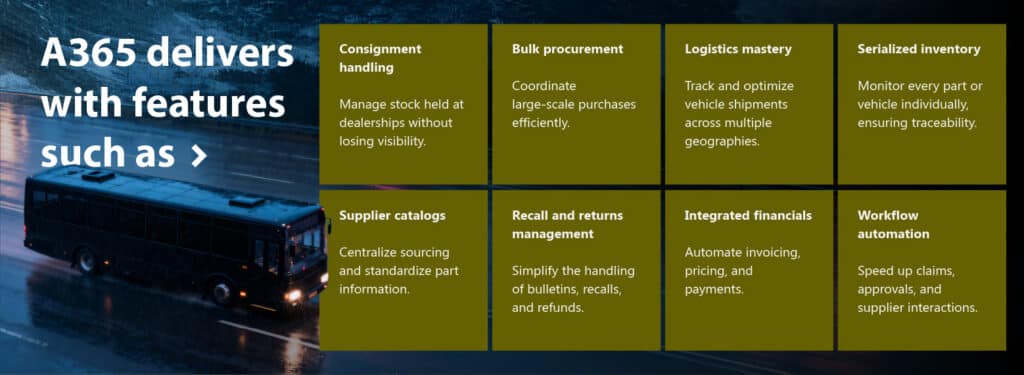
Real-world impact: From survival to strategy
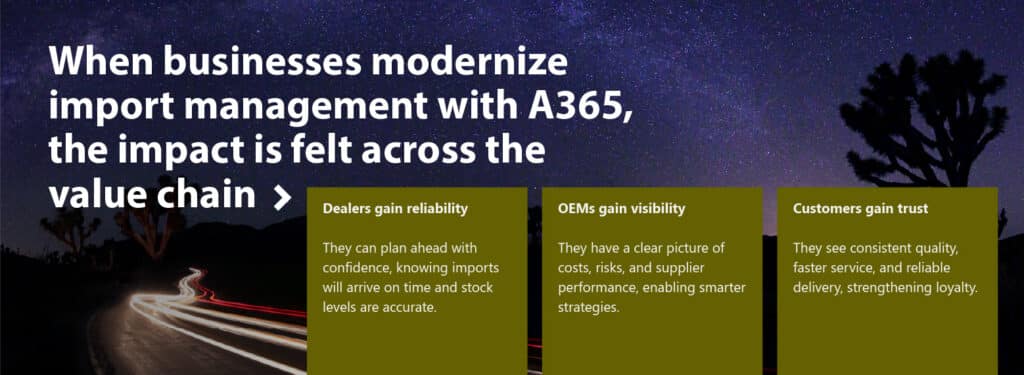
This is not just an IT upgrade. It’s a business transformation that shifts imports from being a daily struggle to becoming a lever for growth and competitive advantage.
Future-ready import management for trucks and buses businesses with Annata
The trucks and buses industry does not stand still, and neither does Annata. A365 is continuously evolving, with investments in AI, advanced analytics, and integration with Microsoft’s roadmap. That means businesses using A365 are not just solving today’s problems; they’re preparing for tomorrow’s opportunities.
Whether it’s predicting risks before they happen, automating complex workflows, or giving suppliers and dealers self-service tools, A365 ensures businesses stay ahead in an unpredictable world.
Final word: Control, confidence, and competitiveness
Import management for trucks and buses businesses will always be complex. But it does not have to be chaotic. With A365 Trucks & Buses Import Management, businesses gain the control, confidence, and competitiveness they need to thrive.
From customs compliance to supplier coordination, from inventory tracking to cost control, A365 brings everything together into one modern platform. The result is not just smoother imports. It’s a stronger, more resilient business that can grow with confidence in the global marketplace.
With A365, you don’t just manage imports. You transform them into a strategic advantage. Get started today by dropping us a note.



